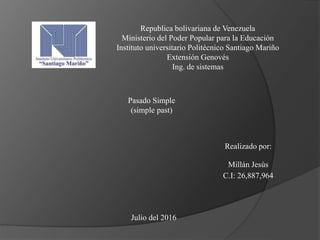Simple past
- 1. Republica bolivariana de Venezuela Ministerio del Poder Popular para la EducaciĻŪn Instituto universitario PolitĻĶcnico Santiago Mari?o ExtensiĻŪn GenovĻĶs Ing. de sistemas Realizado por: MillĻĒn JesĻēs C.I: 26,887,964 Julio del 2016 Pasado Simple (simple past)
- 2. The simple past. It is one of these tenses , present in different languages. The last mention refers to actions already performed previously (ie , who were already completed ) . In Castilian , the simple past also known as single or past perfect tense undefined And is expressed with the past form of the verb and nothing else. ? My grandfather WAS Italian. ? All his life he WAS a teacher. Examples:
- 3. Formation Regular verbs form the simple past in -ed; however there are a few hundred irregular verbs with different forms. For details see English verbs: Past tense. Most verbs have a single form of the simple past, independent of the person or number of the subject (there is no addition of -s for the third person singular as in the simple present). However, the copula verb be has two past tense forms: was for the first and third persons singular, and were in other instances. The form were can also be used in place of was in conditional clauses and the like; for information on this, see English subjunctive. This is the only case in modern English where a distinction in form is made between the indicative and subjunctive moods in the past tense.
- 4. Questions, other clauses requiring inversion, negations with not, and emphatic forms of the simple past use the auxiliary did. For details of this mechanism, see do-support. A full list of forms is given below, using the verb help as an example: ? Basic simple past: I/you/he/she/it/we/they helped ? Expanded simple past: I/you/he/she/it/we/they did help ? Question form: Did I/you/he/she/it/we/they help? ? Negative: I/you/he/she/it/we/they did not (didn't) help ? Negative question: Did I/you/he/she/it/we/they not help? / Didn't I/you/he/she/it/we/they help?
- 5. Usage The simple past is used for a single event (or sequence of such events) in the past, and also for past habitual action: ? He took the money and ran. ? I visited them every day for a year. It can also refer to a past state: ? I knew how to fight even as a child. For action that was ongoing at the time referred to, the past progressive is generally used instead. The same can apply to states, if temporary, but some stative verbs do not generally use the progressive aspect at all ĻC see Uses of English verb forms: Progressive ĻC and in these cases the simple past is used even for a temporary state: ? The dog was in its kennel. ? I felt cold.




